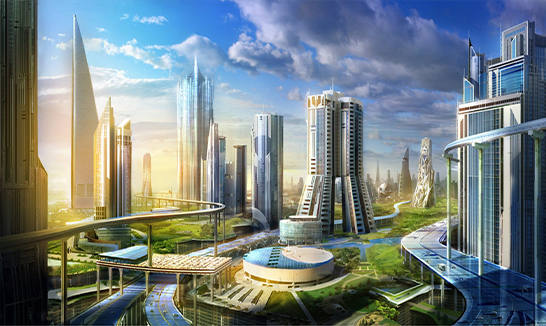
The main objective of a smart city is to optimize city functions & encourage economic growth with a clean & sustainable environment while also enhancing a decent quality of life for citizens by using smart technologies and data analysis. Information and Communication Technology (ICT) has been used to make a city Smart by solving city/urban challenges. The key to the growth of smart cities is not only ICT but also other advanced technologies like the Internet of Things (IoT), Artificial Intelligence (AI), and Geospatial Technology.
GIS for smart cities has become an essential part of our daily lives. It enables to collect the location-based data as well as maintain the spatial database and confirms a seamless flow of information/data and links to the requirements of various stakeholders.
- Construction of the Urban Digital Model
The first step in the implementation of smart city projects concerns the construction of the urban digital model that describes the components of the urban built and natural environments. For each urban component, the digital model provides the geolocalisation and characteristics. GIS is generally used for the construction of the digital model of urban ‘horizontal components’ such as urban networks, transport facilities and natural environment while building information modelling (BIM) is used for the description of ‘vertical components’ such as buildings. The combination of GIS and BIM provides a powerful tool for the construction of the urban digital model with dereferenced data and the visualization of this data in a user-friendly environment.
- Sensing Layer
The second step in smart city projects concerns the construction of the sensing layer that transfers urban operating data to the smart city information system. This layer includes sensors used for monitoring urban networks and infrastructures. Data could also be enhanced by images, videos and audio files resulting in the construction of urban big data. GIS offers the possibility to visualize the monitoring system as well as the sensors’ characteristics and status. It also provides the possibility to visualize real-time and historical data on GIS maps.
- Data Analysis
The third step in implementing a smart city project concerns the development of the analytic environment, which converts real-time and historical data into operational data that improve the security, efficiency and quality of urban systems. The analytic environment includes engineering, management and safety software for urban systems as well as advanced digital tools such as artificial intelligence (AI). In smart city projects, GIS provides tools for geospatial data analysis (distance and directional analysis, geometrical processing, grid models), spatiotemporal analysis, spatial statistics (spatial autocorrelation and regression), surface analysis (surface form and flow analysis, gridding and interpolation methods) and, location analysis (shortest path calculation, facility location).
- Interactive Data Visualization
Interactive data visualization allows users to interact with the smart city’s components and the stakeholders in a user-friendly environment. Web applications are used to create this interactive environment. The use of HTML popups enables users to access web-based content such as graphics referenced by URLs. The interactive GIS graphic environment allows the visualization of urban components and sensors maps. Users and managers can utilize these maps to access static and dynamic data concerning urban systems as well as to update the data.
- Control Layer
Data analysis of historical and real-time data results in commands for the optimal and safe management of urban systems. These commands are transmitted to the control layer, which includes different electronic devices such as smart valves, pumps, motors, switches, breakers and locks. The GIS system allows real-time visualization of these devices as well as their status. It could also visualize faults in device commands.
A geoinformation system’s strength lies in how it is able to analyses spatial data. This is the major difference between GIS and mapping and CAD-based systems. GIS allow users to access and even manage administrative data.